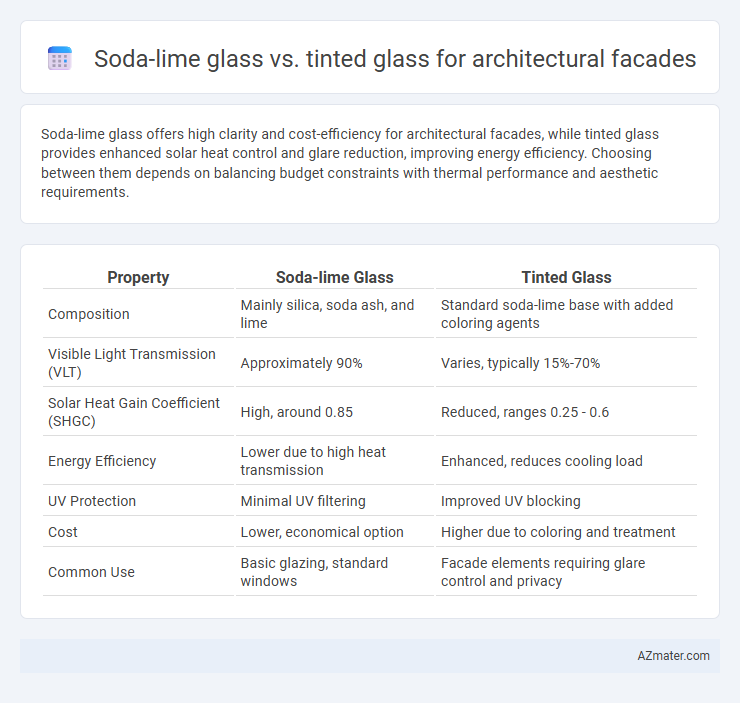Soda-lime glass offers high clarity and cost-efficiency for architectural facades, while tinted glass provides enhanced solar heat control and glare reduction, improving energy efficiency. Choosing between them depends on balancing budget constraints with thermal performance and aesthetic requirements.
Table of Comparison
| Property | Soda-lime Glass | Tinted Glass |
|---|---|---|
| Composition | Mainly silica, soda ash, and lime | Standard soda-lime base with added coloring agents |
| Visible Light Transmission (VLT) | Approximately 90% | Varies, typically 15%-70% |
| Solar Heat Gain Coefficient (SHGC) | High, around 0.85 | Reduced, ranges 0.25 - 0.6 |
| Energy Efficiency | Lower due to high heat transmission | Enhanced, reduces cooling load |
| UV Protection | Minimal UV filtering | Improved UV blocking |
| Cost | Lower, economical option | Higher due to coloring and treatment |
| Common Use | Basic glazing, standard windows | Facade elements requiring glare control and privacy |
Introduction to Architectural Glass
Soda-lime glass, the most common type of architectural glass, offers excellent clarity and cost-effectiveness for facades but lacks inherent solar control properties. Tinted glass incorporates metal oxides or other additives to reduce solar heat gain and glare, enhancing energy efficiency and occupant comfort in building facades. Choosing between soda-lime and tinted glass impacts both aesthetics and thermal performance, influencing the building's overall sustainability and visual appeal.
What is Soda-Lime Glass?
Soda-lime glass is the most common type of glass used in architectural facades due to its cost-effectiveness, durability, and ease of production. Composed primarily of silica, sodium oxide, and calcium oxide, this glass offers excellent clarity and strength for building exteriors. Unlike tinted glass, soda-lime glass maintains natural light transmission without altering color perception, making it ideal for maximizing daylight in architectural designs.
Overview of Tinted Glass
Tinted glass for architectural facades reduces solar heat gain and glare by incorporating metal oxides or dyes, improving energy efficiency and occupant comfort. It offers enhanced privacy and aesthetic appeal with various color options while maintaining structural integrity and durability. Compared to soda-lime glass, tinted glass provides superior solar control and UV protection, making it ideal for modern building designs.
Visual Aesthetic Differences
Soda-lime glass offers high clarity and a neutral color profile, providing bright and transparent facades that enhance natural light penetration and establish a clean, modern appearance. Tinted glass incorporates color additives that reduce glare and solar heat gain, producing facades with varying hues such as bronze, gray, or green that contribute to a sleek, sophisticated look while offering privacy and UV protection. The visual aesthetic difference lies in soda-lime glass's purity and lightness versus tinted glass's ability to create mood, contrast, and energy-efficient shading effects in architectural design.
Light Transmission and Solar Control
Soda-lime glass typically offers high light transmission rates around 80-90%, making it ideal for maximizing natural daylight in architectural facades, but it provides minimal solar control, leading to increased heat gain. Tinted glass reduces light transmission to approximately 30-70% depending on the tint level, significantly enhancing solar control by absorbing and reflecting a portion of solar radiation, thus improving energy efficiency. The choice between soda-lime and tinted glass hinges on balancing daylight requirements with thermal comfort and energy savings in building design.
Energy Efficiency Comparison
Soda-lime glass has moderate thermal insulation properties, allowing natural light while preventing significant heat gain, making it energy-efficient in moderate climates. Tinted glass reduces solar heat gain by absorbing and reflecting infrared rays, enhancing cooling efficiency in buildings situated in hot, sunny environments. Choosing between soda-lime and tinted glass depends on climate-specific energy goals, with tinted glass offering superior solar heat control for reducing HVAC loads.
Durability and Performance
Soda-lime glass, widely used in architectural facades, offers strong durability and excellent thermal insulation but is more prone to heat absorption and glare compared to tinted glass. Tinted glass enhances energy efficiency by reducing solar heat gain and glare, improving occupant comfort while maintaining structural integrity with added UV protection. Both materials suit different performance needs, with soda-lime glass excelling in cost-effectiveness and clarity, while tinted glass optimizes long-term energy savings and facade performance.
Cost and Availability
Soda-lime glass is widely available and cost-effective, making it the most common choice for architectural facades due to its plentiful raw materials and simple manufacturing process. Tinted glass, while more expensive due to additional coatings and treatments, offers enhanced energy efficiency by reducing solar heat gain and glare. The higher upfront cost of tinted glass can lead to long-term savings in cooling expenses, but soda-lime glass remains the more accessible option for budget-conscious projects.
Sustainability and Environmental Impact
Soda-lime glass, commonly used in architectural facades, offers high recyclability and low embodied energy, contributing to sustainable construction practices. Tinted glass reduces solar heat gain and glare, enhancing energy efficiency by lowering cooling loads and reducing dependence on artificial lighting. Both glass types support environmental goals, though the choice depends on balancing material lifecycle impacts with operational energy savings in building design.
Choosing the Right Glass for Your Façade
Soda-lime glass, commonly used for architectural facades, offers high clarity and cost-effectiveness but provides minimal solar control, making it suitable for applications where natural light is prioritized. Tinted glass incorporates additives to reduce solar heat gain and glare, enhancing energy efficiency and occupant comfort while also contributing to the building's aesthetic with various color options. Choosing the right glass depends on balancing factors such as thermal performance, light transmission, visual appearance, and budget to meet specific facade requirements.

Infographic: Soda-lime glass vs Tinted glass for Architectural façade
 azmater.com
azmater.com